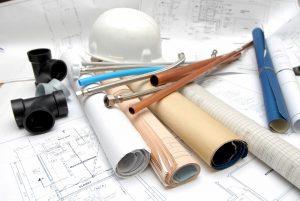You don’t have to know the name and position every pipe in your home or how to service them. That’s what our plumbers are here for. However, we do find it important to know the basics of your plumbing system. That way, you’ll be a bit more prepared to tell your plumber what’s gone wrong when you call for repairs, and you can find water shutoff valves in case of emergency.
Read on to learn about just some of the essential components of your plumbing and drain systems, and contact our team with any questions you have.
1. The Fresh Water Supply
Water comes into your home in one of two ways: from a public water supply or from a well on the property. Wells require frequent maintenance to ensure there’s a steady flow of water at all times (and that the water is clean). Municipal water supplies are pre-pressurized and pre-treated before water gets to your home, but some homeowners choose whole-house filtration anyway.
Hot and Cold Water Lines
Both hot and cold water lines are commonly made of copper today, although galvanized steel was more common decades ago. The cold water lines are the basic water lines that run throughout the home. In some parts of the country, homeowner have to insulate these water lines to protect them from freezing in the winter (but of course, that’s not the case in Florida).
Hot water lines run nearby these and branch off to any appliance or fixture that requires hot water. When you open a hot water tap, water flows from the tank water heater to that faucet—or a tankless water heater is activated.
2. Drain and Sewer Lines
The sewer lines underneath your property may lead out to a septic tank, but more likely they go to the public sewer system. Many people don’t realize that they are responsible for repairing or replacing their own sewer lines all the way out to the street, until the pipe meets the main line.
Drain lines run throughout the home and bring wastewater from sinks, toilets, and showers to the sewer main. Sewer lines used to be made of materials such as clay pipe, concrete pipe, and iron. Today, it’s common to use plastic PVC or ABS piping.
Plumbing Traps
You know how the pipe underneath the sink curves down into a U-shape? It’s actually called a P-trap (as someone decided it looked more like a sideways letter P). It’s the most common trap found in plumbing systems, although U-bends and S-traps can also be found. The trap fills with a bit of water to keep you from having to smell odorous gases that could otherwise escape up through the drains.
Drain Vents
Plumbing vents actually go hand-in-hand with those traps. The vent pipe is the pipe sticking out of the roof, stemming from the drain lines throughout the fixtures in your home. On the one hand, a vent pipe can make sure water goes through the drains smoothly. But it’s mostly there to prevent water from being siphoned from the trap as it drains.
3. Fixtures, Appliances, and More
Of course, your plumbing system has more parts than these. There are plumbing fixtures and appliances at the end of each pipe: sink faucets, floor drains, shower heads, dishwashers, ice makers, and much more. Your plumbing system is rather complex, which is why you need professional technicians to provide service for them.
How to Create a House Plumbing Layout
When you're building a new home, sometimes it's easy to forget about the importance of a plumbing layout or design. It's easy to get caught up in the design and floorplan that the plumbing gets placed on the backburner. Before diving into bathrooms, kitchens, and laundry rooms - consider what goes into your plumbing system.
For example, pipes are connected by so many different fixtures (sinks, showers, toilets, washing machines, dishwashers). While professional designers often put together the house's plumbing diagram - it is important that the homeowner understand the general layout.
Knowing how your home's plumbing system works can help you better describe issues that may arise over time. Rely on the experts to repair and solve issues, but general plumbing layout knowledge can go a long way as a homeowner.
Call an expert plumber in New Port Richey for repair and maintenance services.
Contact the team at Continental Plumbing Services, LLC today!

